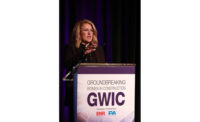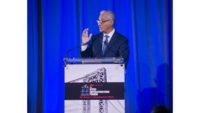The U.S. General Services Administration, with the U.S. Energy Dept., will this year invest another $30 million from the Inflation Reduction Act to boost sustainability of federal buildings through evaluation of 20 novel technologies, GSA Administrator Robin Carnahan told the American Institute of Architects Conference on Architecture last week.
The Green Proving Ground (GPG) program, which weighs emerging and sustainable technologies in real-world settings, is one small part of implementing President Joe Biden’s goal to have the 350 million sq ft of federal buildings at net-zero carbon emissions by 2045, said Carnahan at the event, held June 8-10 in San Francisco.
“We have money and momentum to do really big things,” she added. GSA has a total of $7 billion to spend toward the goal, Carnahan said.
In addition to the expanding the GPG program, GSA has energy retrofits recently completed or under way at 26 border crossings and at other federal real estate, including at the Alfred P. Murrah federal building in Oklahoma City.
“To get to net zero takes a lot of pieces,” said Carnahan, who added that the agency has teams in place to manage each of its programs but also is hiring. “Now is the perfect time to come work for GSA,” she said.
The technology evaluations are intended to validate technical and operational characteristics of those selected and their potential for future wide-scale adoption. The aim is to identify replicable combinations of technologies that deliver net-zero operational emissions.
Since 2011, GPG has evaluated 104 technologies, 23 of which have been deployed across more than one-third of GSA’s federally owned portfolio—avoiding 116,000 annual tons of CO2 and delivering $28 million in annual cost avoidance. For more information, visit gsa.gov/gpg.
This year, GSA has selected 20 emerging and sustainable technologies for real-world evaluation—a four-fold increase over previous years. The agency anticipates results of this year’s evaluations will be available in 2025.
The focus is on seven technology areas:
- Electric Vehicle Supply Equipment technologies toward an all-electric fleet by 2035. Four EVSE technologies will be evaluated: turnkey electric vehicle charging infrastructure from Loop Global, optimized charging through charge management software from bp pulse, a battery-buffered DC fast charger from ADS-TEC Energy and vehicle grid integration (VGI) technology from General Motors LLC.
- Germicidal Ultraviolet technologies that use next-generation LEDs and Far-UVC light to disinfect air without increasing ventilation. The GPG program will evaluate technologies that support healthier buildings while reducing energy use from Far UV Technologies, R-Zero and PURO, a subsidiary of Applied UV Inc. with the Academy Energy Group.
- Greenhouse Gas Accounting technologies, considered essential to achieving 24/7 carbon-free electricity and net-zero operational emissions. Cambio AI and nZero will aim to go beyond annual greenhouse gas reporting to operationally focused carbon management, including near-real-time 24/7 carbon-free electricity insights and impacts.
- Grid-Interactive Efficient Buildings that deliver cost savings by leveraging technologies and strategies that provide continuous demand management and load flexibility. The energy management platform from COI Energy aims to optimize energy use through machine learning, says the GPG program.
- High-Performance technologies that help reduce operational and embodied carbon emissions. The GPG program will evaluate automated aerosol-based duct sealing from Aeroseal; an Internet-of-Things (IoT) lighting system from Signify North America Corp.; and bio-engineered, low-embodied-carbon concrete from Biomason. DOE also will seek commercial partners to validate Toggled, a plug load control solution, and a thermostatic radiator cover and hybrid electrification solution from Kelvin.
- Onsite Renewables considered essential to reducing operational emissions. The GPG program will evaluate an energy storage technology from Yotta Energy—the size of a large laptop—that is installed in place of ballast beneath a rooftop photovoltaic system. The program will also pilot a wind turbine from Accelerate Wind that can be installed at the edge of the building roof and complement rooftop solar.
- Window Retrofit technologies that help improve the performance of a building’s exterior envelope. The GPG program will evaluate three technologies: vacuum-insulated glazing from Pilkington; R14 interior window retrofit system from Vitro Architectural Glass; and a secondary window framing system from Indow.
Some of the technologies will be tested at GSA’s Applied Innovation Learning Labs.
Support for Emerging Professional Architects
Also at the conference, Lakisha Ann Woods, AIA executive vice president, said that the group is on a campaign to support architecture students and emerging professionals. “How can we ensure their voices are being heard?” she asked.
One way is to reduce barriers to licensure, which Woods said is one reason for a significant drop in diversity from architecture graduates to practicing architects. “We support” NCARB to eliminate the rolling clock, she said.
Woods was referring to the action taken by the National Council of Architectural Registration Boards to retire the Architect Registration Examination (ARE) rolling clock policy and implement a new score validity policy, effective May 1. The policy bases the validity of exam scores on versions of the exam instead of on a fixed period of time.
Under the new policy, already passed ARE divisions from both the current and prior versions of the exam will be valid. This national policy change will reinstate the validity of all passed ARE 4.0 divisions taken between 2008 and 2018.
Analysis of the impact of the rolling clock showed that the policy disproportionately affected women and people of color, and continuing the policy would hinder progress toward equity in the architectural profession, says NCARB.
Psychometric study and additional research into exam content showed that the new policy—based on exam version rather than a fixed time frame—would be more effective than the previous policy in ensuring candidate competency.
“This research-backed decision to eliminate the rolling clock policy was unanimously supported by the board of directors and the new score validity policy will maintain the integrity of the exam...,” said Bayliss Ward, NCARB president, in a statement when the organization announced the change.
Ten states and the District of Columbia have existing rules and laws related to the five-year rolling clock policy that may not automatically update with the NCARB change. Those states are Alaska, California, Idaho, Illinois, Kentucky, Maine, New Mexico, South Dakota, Texas and Washington.
NCARB is working with all member licensing boards toward eliminating rolling clock-type policies as soon as possible, said Jared N. Zurn, NCARB vice president, examination.






Post a comment to this article
Report Abusive Comment